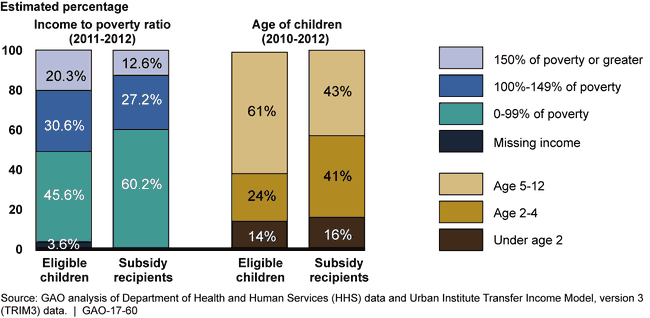Child Care: Access to Subsidies and Strategies to Manage Demand Vary Across States
Highlights
What GAO Found
According to GAO's analysis of nationwide data for an average month in 2011-2012 approximately 8.6 million children under age 13 were estimated to be eligible for subsidies under the Child Care and Development Fund (CCDF) program based on policies in their states, and about 1.5 million received them. When compared with all eligible children, those receiving subsidies tended to be younger (under age 5) and poorer (in families below federal poverty guidelines). (See figure.) Some state-by-state variations existed in these and in other characteristics GAO analyzed, such as race, when comparing children eligible for and receiving subsidies.
Children Eligible for and Receiving Subsidies Based on State Policies

Notes: Percentages may not sum to 100 percent due to rounding. In the poverty graph, margins of error (MOE) are less than +/- 2 percentage points. In the age graph, eligible children have MOEs less than +/- 2 percentage points and data on subsidy recipients are population totals. Figures represent eligibility and receipt in an average month. TRIM3 data were calendar year and HHS data fiscal year.
According to various officials and stakeholders, the number of families receiving subsidies does not equate to the population of eligible families who are interested in pursuing them or who may need them. They also said that it is difficult to accurately predict the extent to which eligible families are likely to apply for and receive subsidies. For example, some eligible families may not pursue subsidies because they may not know about them or find applying burdensome.
Child care officials GAO interviewed said that they use wait lists and other strategies to manage caseloads when more families want subsidies than their states can serve. Wait lists can be challenging to manage, according to child care officials from 23 of the 32 states that GAO interviewed. Challenges included keeping lists current and accurate. Forty states also prioritize certain families for subsidies, such as recipients of the Temporary Assistance for Needy Families program and children in protective services. States also stop taking applications from all or some types of eligible families and modify eligibility policies to manage caseloads. Child care officials also noted that they leverage other programs and funds to meet the child care needs of low-income working families.
Why GAO Did This Study
Child care subsidies help low-income families pay for care, allowing parents to work or attend school or training. Through the CCDF, the federal government provides states funding to assist these families. Federal law sets broad subsidy eligibility requirements and allows states to establish more restrictive policies. Due to limited funds, some eligible families may not be able to get subsidies and may be placed on wait lists.
Congress included a provision in statute for GAO to review participation in the CCDF program across states. GAO examined: (1) what is known about the number and types of families eligible for child care subsidies and the extent to which they receive them; and (2) how states determine which eligible families receive subsidies when subsidy need exceeds supply. GAO used Urban Institute data from 2010-2012 to estimate eligible children (most recent at time of analysis) and U.S. Department of Health and Human Services (HHS) data on subsidy receipt (same years as Urban's data). GAO also held interviews with child care officials from 32 states with wait list policies about subsidy need and management. GAO also interviewed HHS officials and child care stakeholders (selected by reviewing studies and websites, and obtaining suggestions); reviewed federal laws and regulations; and examined state policies in the CCDF Policies Database Book of Tables, an HHS funded project that compiles policies for the 50 states and District of Columbia.
GAO makes no recommendations in this report. HHS noted that the report provides valuable information about access to CCDF subsidies.
For more information, contact Cindy Brown Barnes at (202) 512-7215 or brownbarnesc@gao.gov.
